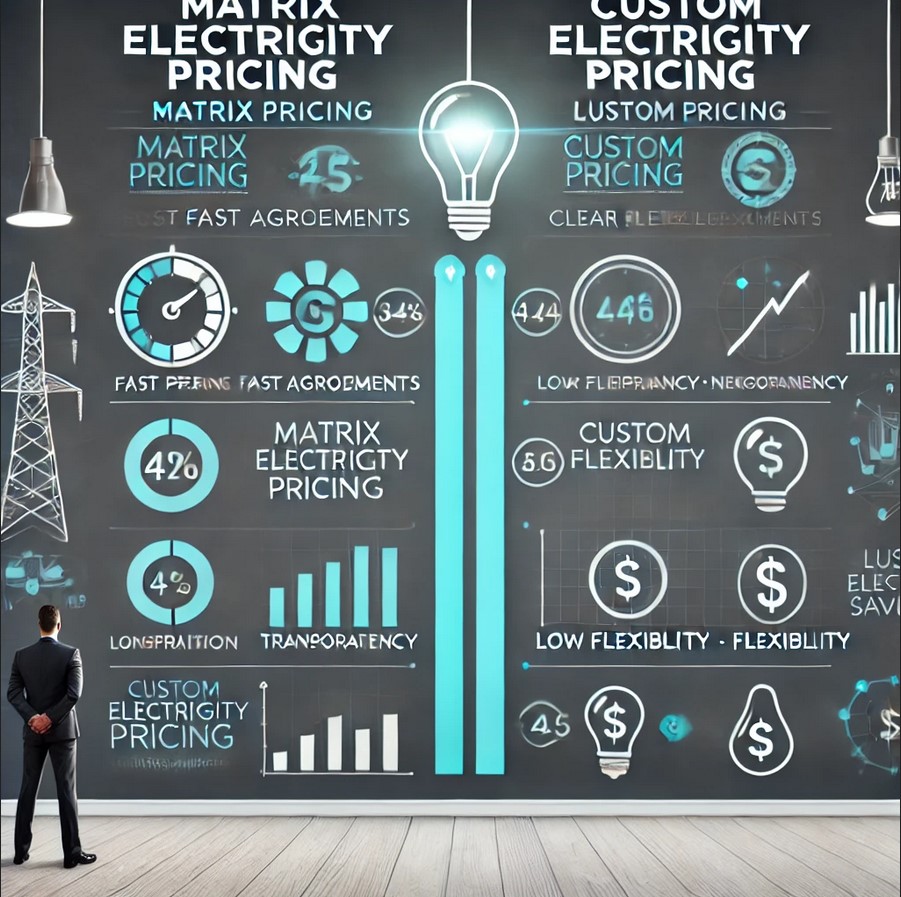Matrix Vs Custom Pricing

Matrix Electricity Pricing vs. Custom Electricity Pricing: Which is Better for Your Business?
Choosing the right electricity pricing model is crucial for businesses looking to manage their energy costs effectively. Two common pricing structures in the commercial electricity market are Matrix Electricity Pricing and Custom Electricity Pricing. But which one is the best fit for your business? This guide will break down the differences, advantages, and disadvantages of each pricing option, helping you make an informed decision.
What is Matrix Electricity Pricing?
Matrix pricing is a standardized electricity pricing model that provides pre-set rates based on factors such as business size, location, and contract length. Suppliers publish these rates in a pricing matrix, allowing businesses to choose an option that suits their needs quickly.
Advantages of Matrix Pricing
- Speed and Simplicity – Since rates are pre-determined, businesses can lock in pricing quickly without lengthy negotiations.
- Transparency – Matrix pricing provides clear, upfront rates, making it easier to compare options.
- Competitive Pricing for Standard Profiles – Small and mid-sized businesses with predictable energy consumption can benefit from cost-effective rates.
Disadvantages of Matrix Pricing
- Limited Flexibility – Prices are based on predefined criteria, which may not accommodate businesses with unique energy consumption patterns.
- Lack of Customization – Businesses with specific energy needs, such as seasonal fluctuations, may not get the best deal.
- May Not Reflect Real-Time Market Trends – Matrix pricing updates periodically, meaning businesses might not get the lowest rates available at the moment of purchase.
What is Custom Electricity Pricing?
Custom electricity pricing, also known as tailored pricing, is a personalized approach where electricity suppliers analyze a company’s energy usage and design a unique pricing structure. This model is commonly used by large enterprises or businesses with complex energy needs.
Advantages of Custom Pricing
- Optimized Cost Savings – Custom pricing allows businesses to negotiate rates based on their specific usage, often securing better deals than matrix pricing.
- Market-Based Pricing Adjustments – Businesses can leverage real-time market fluctuations to obtain lower rates.
- Flexible Contracts – Custom contracts can include provisions for peak usage, off-peak discounts, and demand response programs.
- Better Fit for Large Businesses – High-consumption businesses benefit from detailed rate structures that reduce overall energy costs.
Disadvantages of Custom Pricing
- Longer Negotiation Process – Businesses must go through a detailed pricing and contract negotiation phase, which can take more time.
- Requires Expert Knowledge – Understanding energy markets and price trends is essential to ensure the best deal.
- Not Always the Best for Small Businesses – Small energy consumers may not benefit significantly from the effort required for custom pricing.
Which Option is Better for Your Business?
The best choice depends on your business's size, energy consumption pattern, and need for flexibility. Below is a quick comparison to help you decide:
| Feature | Matrix Pricing | Custom Pricing |
|---|---|---|
| Best for | Small-to-mid-sized businesses | Large businesses or those with complex energy needs |
| Pricing Transparency | High – Rates are pre-published | Low – Negotiated and customized |
| Speed of Agreement | Fast – Standard contracts available | Slower – Requires negotiation |
| Flexibility | Low – Limited to predefined rate options | High – Customized to business needs |
| Market Responsiveness | Moderate – Updates periodically | High – Can reflect real-time market changes |
| Savings Potential | Competitive for standard energy users | Higher for businesses with large or unique energy demands |
| Load Factor Impact | Best for businesses with Low load factor | Best for businesses with High load factor |
Case Study: How Custom Pricing Helped a Manufacturing Company Save 20%
A manufacturing company in Pennsylvania was previously using Matrix Pricing for its electricity supply. Due to seasonal production spikes, the company often faced higher peak demand charges. After switching to Custom Pricing, the business secured a contract that:
- Included a demand response program, reducing costs during peak usage.
- Leveraged real-time pricing to secure lower rates during off-peak hours.
- Achieved a 20% reduction in annual energy costs compared to matrix pricing.
This case highlights how businesses with high or variable energy needs can significantly benefit from a tailored approach.
How to Get the Best Commercial Electricity Pricing
- Assess Your Energy Needs – Analyze your historical energy usage and identify any patterns.
- Compare Pricing Models – Consider both matrix and custom pricing based on your business profile.
- Consult with Energy Experts – Work with a commercial energy broker or supplier to explore the best rates.
- Request Multiple Quotes – Get offers from various suppliers to compare terms and pricing.
- Monitor Energy Market Trends – Stay informed about electricity rate fluctuations to time your contract effectively.
Conclusion
Both Matrix Electricity Pricing and Custom Electricity Pricing have their advantages. If you run a small-to-mid-sized business with predictable energy usage, matrix pricing offers a fast and transparent way to secure competitive rates. However, if you operate a large or energy-intensive business, custom pricing may provide greater savings and flexibility.
Ready to Compare Commercial Electricity Pricing?
Find out which pricing model is best for your business by getting a free commercial electricity quote today.
